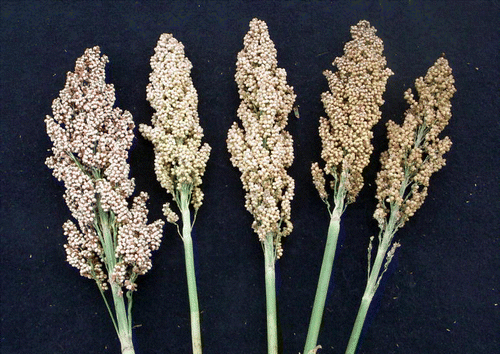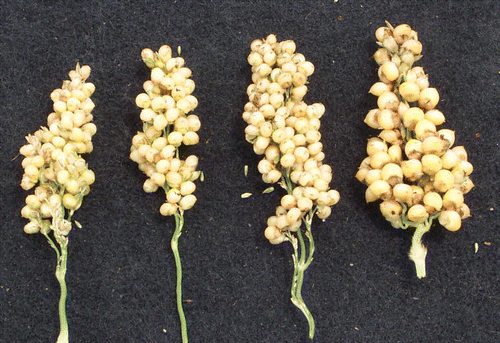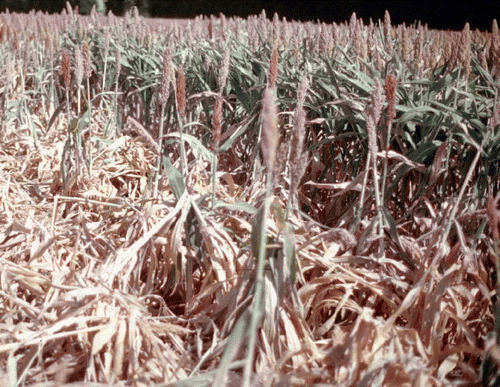Abstract
Sorghum has been grown as a food crop for many centuries in Africa and India. Food-grade sorghum is becoming an increasingly important crop in the developed world, especially as a cereal grain option for people with celiac disease. The highest quality sorghum flours and food products are produced using grain from food-grade sorghum varieties. Food-grade sorghum varieties differ from conventional varieties in several key traits. The objective of this review article is to describe and summarize these differences and important considerations for food-grade sorghum production.
Keywords:
Overview
Sorghum is recognized as an important crop throughout the arid tropical and sub-tropical regions of Africa, Asia, and Central America. Given its natural tolerance to heat and drought stress, sorghum is a key crop in providing food security for millions of people in these regions. In Africa, most of the grain is used to prepare foods and beverages for human consumption including traditional stiff or thin porridges (e.g., tô and fura), granulated foods (e.g., couscous), and beer (e.g., dolo) (Awika and Rooney Citation2004; Dicko et al. Citation2006). Increasing amounts of sorghum also are being used for animal feed, especially for poultry production in areas where sorghum is sold at a discounted price compared to other grains (e.g., Niger).
Sorghum also is important in the developed temperate regions of the Americas, Australia, and Europe. In these areas, sorghum production is increasing in response to expanding market opportunities for use of the grain in industrial applications such as ethanol production and in new food products, especially as a cereal option for people with celiac disease. Specific food-grade sorghum varieties have been developed to meet the processing needs for these new food products.
Food-grade sorghum and quality considerations
The highest quality sorghum flours and food products are produced using grain from tan-plant, food-grade sorghum varieties (Rooney and Waniska Citation2000). Several key traits are considered in developing food-grade sorghum varieties including white pericarp color, thin mesocarp, normal endosperm type, low tannin content, and tan-plant necrotic lesion color ().
Figure 1. Food-grade sorghum varieties are defined by several key traits including white pericarp color, thin mesocarp, normal endosperm type, low tannin content, and tan-plant necrotic lesion color.

Many of the genes that determine these physical and biochemical traits of sorghum are known (Reviewed by Rooney Citation2000). Variation in color of the epicarp is known to be influenced by the action and interactions of the R, Y, I, Pb, Pt, P, and Q genes. Kernel mesocarp thickness is determined by the effects of Z. Endosperm color is influenced by the presence of carotenoid pigments and genetic inheritance appears to be complex. Genes involved in starch biosynthesis, such as waxy (wx), are known to influence endosperm type by causing a shift in the amylose/amylopectin ratio. Tannin content and accumulation patterns are influenced by the presence or absence of a testa layer which is determined by the effects and interactions of the B 1 , B 2 , and S genes. Tannins are known anti-nutritional factors and are not found in improved sorghum varieties. The high lysine trait (hl) might someday play an important role in sorghum enhancement; however, this trait conditions extreme susceptibility to grain molds and weathering which limits potential for transfer to locally adapted varieties and hybrids (Singh and Axtell Citation1973). Other key traits associated with sorghum grain quality are those physical attributes that affect processing characteristics (e.g., kernel size, shape, hardness, etc.).
Food grade sorghum varieties and hybrids have been developed to maximize potential food quality, but these types of sorghum tend to be more susceptible to mold than sorghum varieties with a red pericarp. Grain molds result from fungal infections (generally Fusarium thapsinum and/or Curvularia lunata) that occur at anthesis and/or during and after grain development. Fungal tissues that may contain mycotoxins may also be present and even replace the seed in extreme cases (Da Silva et al. Citation2000). Food-grade sorghum hybrids express tremendous variation in grain mold resistance under humid and/or wet conditions (). Susceptible varieties produce grains and panicles with extensive molding that result in dark-colored flours and food products. Grain mold resistant varieties produce clean grains that result in light-colored flours and food products.
Figure 2. Food-grade sorghum varieties show tremendous variation in grain color, weathering tolerance, and mold resistance under humid and/or wet conditions. Susceptible varieties produce grains and panicles with extensive molding (right) that result in dark-colored flours and food products. Grain mold resistant varieties (left) produce clean grains that result in light-colored flours and food products.

Producers must take special care to ensure that cultivars selected for planting have adequate grain mold resistance to match the production environment. Grain mold and weathering resistance ratings are available for some hybrids; however, it may be necessary to test and evaluate numerous varieties in a particular production environment to identify those having the most appropriate attributes.
Several other traits have also been identified that improve grain and/or flour color characteristics. Sorghum glume color can play an important role in grain quality. Glume color in sorghum can range from black, dark-brown, or purple to light-tan or straw color (). Sorghum varieties with light glume color tend to produce grain and flour with better color characteristics. Another important quality consideration is kernel size (), kernel hardness, and decortication yield. Varieties with large or bold grains are preferred to small or soft grain types and typically have higher flour yields.
Figure 3. Glume color in food-grade sorghum varieties can vary from dark brown or black (left) to tan or straw color (right). Varieties with tan or straw colored glumes generally are preferred by processors.

Figure 4. Seed size can vary by as much as 4-fold among varieties. Given adequate grain mold resistance, large-seed sizes generally are preferred to improve milling and processing characteristics of food-grade sorghum.

The functional food and feed traits and characteristics of sorghum (e.g., pasting temperature, taste, amylase activity, shelf-life etc.) are not well understood, but studies in other cereal crops suggest that these traits may be influenced in part by genes and enzymes involved in the starch, protein, and lipid biosynthesis pathways. Recent gene mapping studies in maize and rice have shown that specific alleles of genes in the starch biosynthesis pathway (e.g., starch synthases, branching, and de-branching enzymes) are associated with variation in functional endosperm quality traits (Han et al. Citation2004; Wilson et al. Citation2004; Yamanaka et al. Citation2004; Nakamura et al. Citation2005). With sequencing of the sorghum genome nearly completed and draft sequence already available, geneticists and plant breeders now have a new tool that will facilitate an objective assessment of the effects of genes and natural genetic diversity influencing grain quality and functional food and processing traits in sorghum. This information will allow systematic evaluation of the genes and genetic resources that are available in sorghum to more effectively mine the natural gene pool of sorghum.
Food-grade sorghum production
Grain sorghum was first introduced to the United States over 125 years ago. Brown Durra and White Durra varieties were introduced into the Central Valley of California in the 1870s. Farmers were quick to recognize the higher nutritional value of the low-tannin, white-seeded variety and it was widely produced as new crop in Southern California. Other sorghum landrace accessions from Africa and India were introduced into the United States in subsequent years and the crop gained wide acceptance throughout the Southwest and Central Great Plains region of the United States as locally-adapted varieties were identified by farmers and researchers.
Hybrid sorghum varieties were developed and first marketed to farmers in the United States in the mid-1950s. Hybrids provided tremendous yield advantages over varieties. Inbred and hybrid cultivars show significant variation in yield potential, adaptation, and grain quality characteristics so cultivar selection is one of the most important considerations in crop management. To help growers identify cultivars with the best local-adaptation, many universities conduct variety performance trials. Grain yield, maturity, and resistance to lodging are the most important criteria to consider when selecting food-grade sorghum cultivars.
Grain yield
Comparisons of hybrid variety yields often show variation of more than 3 Mg ha−1. Yield is an expression of the effects of many genetic and environmental influences and interactions. The components of yield include panicle number, seeds panicle−1, and seed weight. Variety selection should entail careful consideration of which cultivar provides the highest and most consistent yield given specific quality parameters. Multi-year and multi-location trials generally provide the best information in making a variety selection.
Maturity
Grain yield potential correlates strongly with maturity. Under equal and favorable growing conditions, a good full-season hybrid will out-yield an early-season hybrid in most years. Producers should select a hybrid based on limitations of projected moisture availability, average length of growing season, and crop sequence. Many food-grade sorghum varieties are long-season types and care should be taken to ensure that varieties match local production conditions.
Lodging resistance
It is much easier to harvest high-quality grain from a standing crop than from a crop that has fallen to the ground. Standability generally is not a problem in sorghum when a crop matures under good conditions; however, drought stress during later stages of crop development can induce susceptibility to invasion by organisms, such as charcoal rot and Fusarium stalk rot, which cause lodging (). Food-grade sorghum producers should avoid hybrids that show susceptibility to stalk or root lodging.
Conclusion
Food-grade sorghum production is expanding in response to new market opportunities for high-value food products. High-yielding, food-grade sorghum cultivars have been developed to meet a range a maturity and adaptation considerations, but producers and end-users must take care that inbred or hybrid varieties are selected to meet production constraints and end-use requirements.
References
- Awika , JM and Rooney , LW . 2004 . Sorghum phytochemicals and their potential aspects on human health . Phytochemistry , 65 : 1199 – 1221 .
- Da Silva , JB , Pozzi , CR , Mallozzi , MAB , Ortega , EM and Correa , B . 2000 . Mycoflora and occurrence of aflatoxin B1 and fumonisin B1 during storage of Brazilian sorghum . J Agriv Food Chem , 48 : 4352 – 4356 .
- Dicko , MH , Gruppen , H , Traore , AS , Voragen , AGJ and van Berkel , WJH . 2006 . Sorghum grain as human food in Africa: Relevance of content of starch and amylase activities . Afr J Biotechnol , 5 : 384 – 395 .
- Han , Y , Xu , M , Liu , X , Yan , C , Korban , S , Chen , X and Gu , M . 2004 . Genes coding for starch branching enzymes are major contributors to starch viscosity characteristics in waxy rice (Oryza sativa L.) . Plant Sci , 166 : 357 – 364 .
- Nakamura , Y , Francisco , PB Jr , Hosaka , Y , Sato , A , Sawada , T , Kubo , A and Fujita , N . 2005 . Essential amino acids of starch synthase IIa differentiate amylopectin structure and starch quality between japonica and indica rice varieties . Plant Mol Biol , 58 : 213 – 227 .
- Rooney , WL . 2000 . “ Genetics and cytogenetics ” . In Sorghum: Origin, history, technology, and production , Edited by: Smith , CW and Frederiksen , RA . 261 – 307 . New York : John Wiley & Sons, Inc .
- Rooney , LW and Waniska , RD . 2000 . “ Sorghum food and industrial utilization ” . In Sorghum: Origin, history, technology, and production , Edited by: Smith , CW and Frederiksen , RA . 689 – 729 . New York : John Wiley & Sons, Inc .
- Singh , R and Axtell , JD . 1973 . High lysine mutant gene (hl) that improved protein quality and biological value of grain sorghum . Crop Sci , 13 : 35
- Wilson LM , Whitt SR , Ibanez AM Rocheford TR , Goodman MM , Buckler ES 4th. 2004 . Dissection of maize kernel composition and starch production by candidate gene association . Plant Cell 16 : 2719 – 2733 .
- Yamanaka , S , Nakamura , I , Watanabe , KN and Sato , Y . 2004 . Identification of SNPs in the waxy gene among glutinous rice cultivars and their evolutionary significance during the domestication process of rice . Theor Appl Genet , 108 : 1200 – 1204 .
